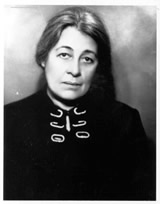
(1886-1939)
Educational Psychologist
Influences
- Student of: E. L. Thorndike
- Influenced by:
- Students:
- Influenced:
- Time Period: The Great Schools’ Influence
Education
- University of Nebraska-Lincoln (B.A., 1906)
- Teachers College (M.A. in Education, 1913; Ph.D. in Educational Psychology, 1916) – Under E. L. Thorndike
Career
- Assistant principal of School District No. 6, Saline County, Nebraska
- Teacher at McCook High School
- Clearing-House for Mental Defectives (she administered Binet tests) (1913)
- Clinical Psychologist at Bellevue Hospital (1915)
- Consulting Psychologist to New York Police Department (1915)
- Teachers College, Columbia University — Professor of Educational Psychology
Major Contribution
- Wrote first comprehensive text on the gifted
- Taught first college course on the gifted
- Commenced one of the first systematic studies of children with intelligence quotients (IQ) above 180
- Listed in American Men of Science
Ideas and Interests
Although Leta Stetter Hollingworth is perhaps best known for her work with exceptional children (discussed below), she also performed pioneering work in the field of psychology of women, which greatly overlaped with issues of intelligence and intellectual ability. In the early 1900s, there were two commonly held beliefs regarding women that Hollingworth scientifically examined. First, it was generally accepted by many members of society (particularly those in power) that women were mentally incapacitated during menstruation. Based on this belief, many employers would not hire women because they believed it was not possible for them to be as productive as men and would not be able to handle major responsibilities due to their monthly impairments. Hollingworth empirically tested this hypothesis and found that women’s performance on several cognitive, perceptual, and motor tasks was similar to that of males, even during menstration.
A second premise that sparked the interest of Hollingworth was the variability hypothesis which asserted that women as a group were more similar than men as a group; that is, men have a much wider range of talents as well as defects than do women. This proposition was used to explain why there were more men who were geniuses as well as more men who were mentally deficient and in institutions. The correlate of this premise is that women will never be able to achieve the highest achievements and would have to settle for mediocrity. In a large study, Hollingworth examined 1,000 male newborns and 1,000 female newborns and found no greater inherent variability in males than in females.
In the 1920s, Hollingworth’s efforts shifted to the study of children, particularly exceptional children. Much of her work on giftedness was being conducted at the same time as Terman’s study on giftedness. While the two individuals never met, they had great respect for each other and the work each was doing. Many of Terman’s beliefs about giftedness coincided with those held by Hollingworth, but they diverged on one major point. Terman believed that giftedness was inherited and was only interested in defining and describing giftedness. Although Hollingworth acknowledged the role of inheritance in giftedness, she also believed that educational and environmental factors played key roles in the development of potential. Resultantly, Hollingworth was more interested in how to properly nurture giftedness and how to appropriately educate gifted individuals.
One of Hollingworth’s most notable studies regarding giftedness was sparked in November, 1916, when she saw for the first time a child test above 180 IQ on the Stanford-Binet (S-B). She became intrigued, and over the span of the next 23 years was able to find 11 other children in the New York City region with such intellectual giftedness and attempted and in-depth study of their genius. Knowing that she would never live long enough to see all of the children well into their adult lives, she meticulously attempted to build a framework upon which great future research and findings could be accomplished. She deserves much credit for pioneering into such a challenging field. Those who test above 180 IQ (S-B) are characterized by a strong desire for personal privacy, seldom volunteer personal information, do not like to have attention called to their families and homes, and are afraid of the potential ramifications of being labeled as “special” in society. Amidst all of these concerns, Leta S. Hollingworth conducted research consistent both with scientific interest and with the preservation of personal privacy in mind. She laid a foundation for the study of truly gifted children.
Publications
- The Psychology of Subnormal Children (1920)
- Special Talents and Defects (1923)
- Gifted Children: Their Nature and Nurture (1926)
- The Psychology of the Adolescent (1928)
- Children Above 180 IQ Stanford-Binet: Origin and Development (1942)
References: 13
Image Courtesy of the Archives of the History of American Psychology, The University of Akron
